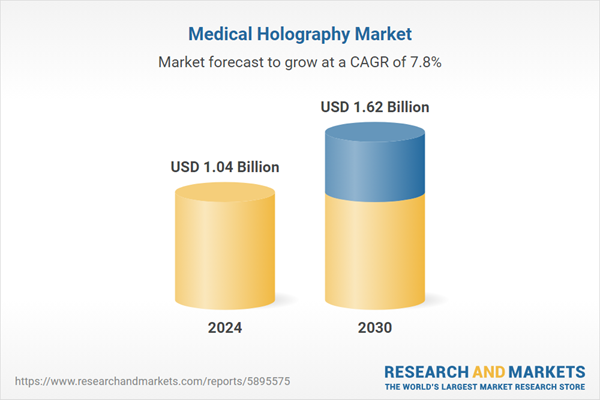Speak directly to the analyst to clarify any post sales queries you may have.
10% Free customizationThis report comes with 10% free customization, enabling you to add data that meets your specific business needs.
This demand is further accelerated by a global rise in chronic diseases, an aging population, and the shift toward non-invasive diagnostic methods. Applications span surgical simulation, medical training, and patient engagement, where holography improves understanding and outcomes. As healthcare providers increasingly adopt digital imaging and personalized treatment methods, the integration of holography into medical workflows is expected to continue expanding. Growth is also supported by investments in research and the introduction of portable, user-friendly holographic systems that meet evolving healthcare needs.
Key Market Drivers
Growing Demand for Non-invasive Medical Procedures
The increasing preference for non-invasive medical interventions is a key driver of the global medical holography market. These procedures are associated with shorter recovery times, reduced risks, and lower healthcare costs. Medical holography enables clinicians to visualize internal anatomy non-invasively, allowing precise diagnosis and planning without surgical intrusion. By projecting high-resolution 3D images of organs and tissues, holography improves surgical outcomes and aids in patient consultation. The ability to avoid invasive diagnostics while maintaining accuracy and efficiency has increased adoption among both healthcare professionals and patients, further supporting market growth.Key Market Challenges
Technological Complexity and Integration
A major barrier to widespread adoption of medical holography lies in the complexity of the technology itself. Developing holographic systems that deliver high-resolution, real-time imaging while remaining user-friendly and compatible with existing hospital systems requires extensive engineering and coordination. Integration with legacy medical imaging equipment and digital health records can be difficult and costly, limiting implementation in resource-constrained settings. Additionally, the need for training and change in clinical workflows presents resistance among some medical professionals. These challenges contribute to slower adoption and necessitate collaboration among developers, clinicians, and regulators to streamline integration and enhance usability.Key Market Trends
Augmented Reality (AR) Integration in Surgical Procedures
The convergence of AR and medical holography is reshaping modern surgical techniques. AR-enabled holographic systems are being used to overlay 3D anatomical models onto the surgeon’s field of view, providing real-time guidance during complex procedures. This integration enhances spatial awareness, precision, and surgical planning by allowing clear visualization of vital structures like blood vessels or tumors. As AR tools become more advanced and accessible, they are increasingly incorporated into surgical practice, reducing complications and improving patient outcomes. The immersive nature of AR-supported holography is expected to become a standard in operating rooms, especially in high-risk or minimally invasive procedures.Key Market Players
- Holografika Kft
- EchoPixel Inc
- EON Reality Inc.
- Hexagon AB
- Holoxica Ltd
- Nanolive SA
- Phase Holographic Imaging PHI AB
- RealView Imaging Ltd
- Zebra Imaging Inc.
- zSpace Inc
Report Scope:
In this report, the Global Medical Holography Market has been segmented into the following categories, in addition to the industry trends which have also been detailed below:Medical Holography Market, By Product:
- Holographic Displays
- Holography Microscopes
- Holographic Prints
- Holographic Software
- Other
Medical Holography Market, By Application:
- Imaging in Medical Indications
- Medical Education
- Other
Medical Holography Market, By End-User:
- Hospitals/Clinics
- Biopharmaceutical Companies
- Other
Medical Holography Market, By Region:
- North America
- United States
- Canada
- Mexico
- Europe
- France
- United Kingdom
- Italy
- Germany
- Asia-Pacific
- China
- India
- Japan
- Australia
- South Korea
- South America
- Brazil
- Argentina
- Colombia
- Middle East & Africa
- South Africa
- Saudi Arabia
- UAE
Competitive Landscape
Company Profiles: Detailed analysis of the major companies present in the Global Medical Holography Market.Available Customizations:
With the given market data, the publisher offers customizations according to a company's specific needs. The following customization options are available for the report.Company Information
- Detailed analysis and profiling of additional market players (up to five).
This product will be delivered within 1-3 business days.
Table of Contents
Companies Mentioned
- Holografika Kft
- EchoPixel Inc
- EON Reality Inc.
- Hexagon AB
- Holoxica Ltd
- Nanolive SA
- Phase Holographic Imaging PHI AB
- RealView Imaging Ltd
- Zebra Imaging Inc.
- zSpace Inc
Table Information
| Report Attribute | Details |
|---|---|
| No. of Pages | 183 |
| Published | June 2025 |
| Forecast Period | 2024 - 2030 |
| Estimated Market Value ( USD | $ 1.04 Billion |
| Forecasted Market Value ( USD | $ 1.62 Billion |
| Compound Annual Growth Rate | 7.7% |
| Regions Covered | Global |
| No. of Companies Mentioned | 10 |









